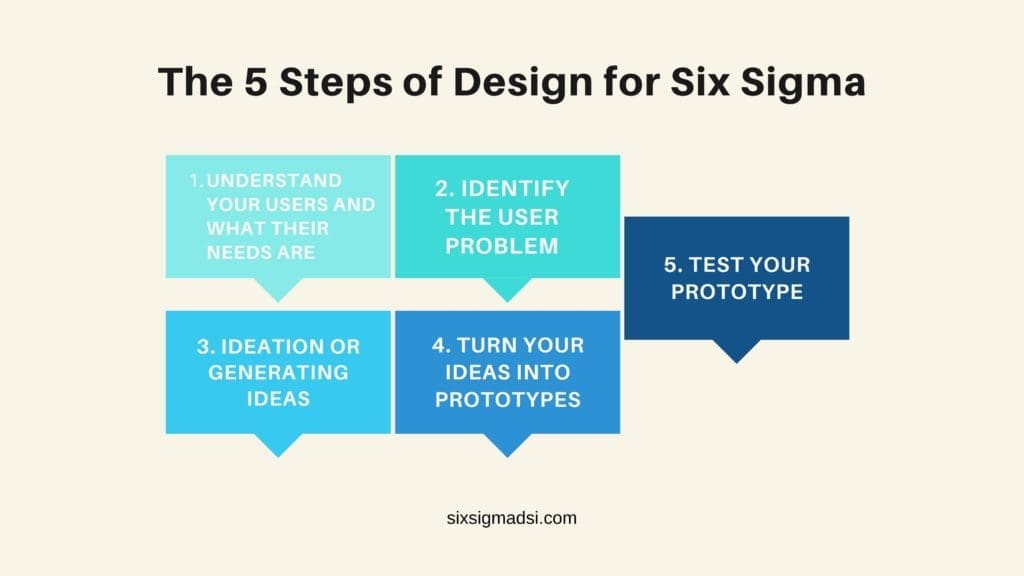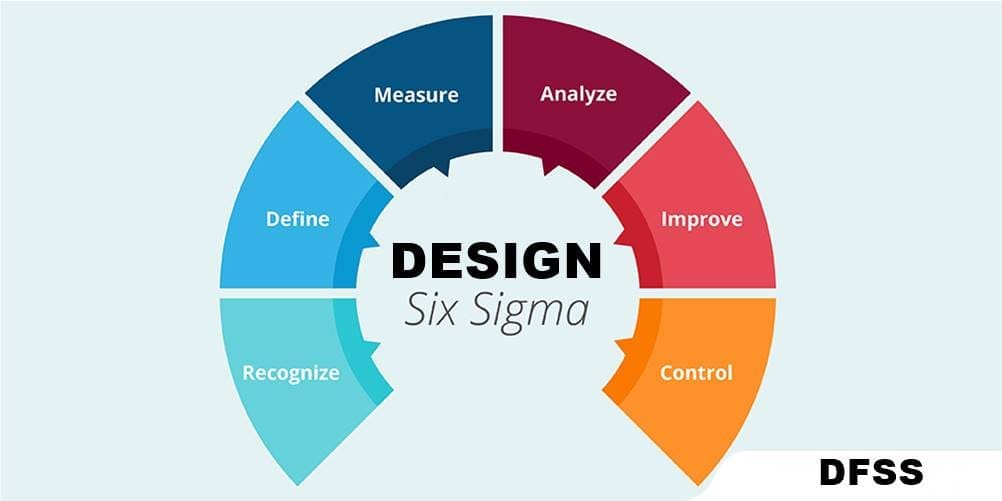Table of contents
What Is Design For Six Sigma?
The global marketplace is a place where competition has never been greater. There are many similar products available to consumers. Many manufacturing companies strive to create new products and enter new markets. Some products are designed to meet consumer expectations, while others do not. The company will often redesign the product. They may even test and develop multiple iterations before reintroducing the product. It is expensive and wasteful to redesign a product multiple times. It would be more beneficial to have a product that met the needs and expectations of customers, with higher levels of quality from the start. The Design for Six Sigma (DFSS) degree training program for black belts, focuses on doing additional work upfront to ensure that you fully understand your customer’s expectations and needs before the design is completed. DFSS demands that all stakeholders be involved in each function. You can improve the quality of new table products and processes by using a Design for Six Sigma method.
What is Design for Six Sigma?
Design for Six Sigma training is a new approach to product and process table development. It uses multiple methodologies. The traditional Six Sigma uses DMAIC, or Define, Measure, Analyze, Improve, and Control. This method is most useful when it’s used to make small changes to the design of a product or to improve an existing process. Design for Six Sigma, on the other hand, is used to completely redesign a product or a process table. The Design for Six Sigma (DFSS) black belt table process seems to be implemented differently by each business or organization. DMADV is one example, as are DCCDI and IDOV. All the methods seem to focus on understanding customer needs and applying that information to product and process designs. To ensure that the entire product is considered, the DFSS team needs to be cross-functional. This includes market research, design, implementation of processes, and product launch. DFSS aims to minimize defects and variations by designing products and processes. According to reports, a process that is developed using DFSS should have a 4.5 sigma level or higher.
Why Implement Design for Six Sigma?
Your company will need a lot of resources and time to design a product or a process from scratch. Today’s products are complex and there are many ways for something to go wrong. Your product’s sales will suffer if your design doesn’t meet the actual wants and needs of the customer or if your product doesn’t provide the value that the customer is willing to pay. It is costly to redesign products and processes and it increases the time you take to market. By utilizing Design for Six Sigma table methods, companies have been able to reduce their time to market from 25 to 40% while providing high-quality products that meet the customer’s needs. The Design for Six Sigma degree is a proactive design approach that uses quantifiable data, and proven design tools and can increase your chances of being successful.
When to implement Design for Six Sigma
Design For Six Sigma training is best used to design a new product or service. DFSS can be used when a product must be replaced instead of redesigned. It is time to replace a product or a process that cannot be improved in order to meet the customer’s requirements. The DFSS methods are not intended to be used for incremental changes to a design or process. DFSS can be used to prevent quality issues. As a black belt, you can use the DFSS method and approach to achieve your goals of optimizing your design, meeting the actual needs and expectations of your customers, reducing the time to market, and providing a high-quality initial product.
How to implement Design for Six Sigma?
A Design for Six Sigma black belt (DFSS) degree, as previously stated, is more of an approach than a specific table methodology. Each of the methods has some common characteristics. A cross-functional team should be involved in the DFSS project. The team should focus on customer requirements and Critical To Quality (CTQ) parameters. Before developing a new design, the DFSS team must spend time understanding and studying the problems with existing systems. DFSS is implemented using a variety of methodologies. Below is a description of DMADV, one of the most popular techniques.

Define
Define should include a Project Charter, Communication Plan, and Risk Assessment / Management Plan.
The Project Charter
The team should create a Project Charter that should include the following:
- The purpose or reason behind the project, preferably with quantifiable targets or data.
- Voice of Business: What the business hopes to gain by completing the project
- Project Scope: Establish the scope of the project, and what exactly is included and excluded from the scope of the project. This will prevent “project creep”.
- Problem identification or identifying the gap between the present and desired state
- Goals for improving revenue, customer satisfaction, or market share should be stated as well-defined, measurable targets
- Schedule or timeline for the project with clearly defined gates and deliverables at each gate.
- Project Budget – Cost target for the entire project, including capital expenditures
- Identification of key stakeholders and the sponsoring project
- Identification of cross-functional teams
- Clarification of roles for team members and stakeholders
Communication Plan
During the Define stage, the team must develop a communication strategy that will be used throughout the entire project. The Communication Plan must address the different aspects and techniques of discussing evaluation results. The plan should guide the process of successfully sharing results from the evaluation. Answer the following questions to develop a Communication Plan.
- Who is the main contact person on the team responsible for communication?
- What are the main communication goals?
- Who is your audience? (Identify target audience)
- When and how frequently will communication take place?
- What will the communication methods be?
Risk Assessment or Risk Management Plan
The project manager must prepare a Risk Assessment or Risk Management Plan, which includes the following information, but not only:
- Project risks
- Risks and their impact on the success of a project
- Plan/outline for managing project risks
Measure
During the measurement phase, the focus of the project is to understand customer needs and desires and translate them into measurable requirements for design. The team should focus not only on requirements, or “Must Haves”, but also on “Would Likes”, or features or functions which would excite customers and set your product apart. Customer information can be collected in a variety of ways, including:
- Customer surveys
- Visits to dealers or sites
- Information on warranty or customer service
- Historical Data
- Consumer Focus Groups
Analyze
In the Analyze Phase, the information from the customer should be captured and converted into measurable design performance or functional requirements. This information is captured and translated using the Parameter (P). These requirements should be translated into system, sub-system, and component-level design requirements. The QFD and the Characteristic Matrix can be used to drive the customer’s needs from the machine level down to component level requirements. The team can then use this information to create multiple design concepts. Different assessment tools, such as benchmarking or brainstorming, can be used in order to assess how well the different design concepts match customer and business needs and their likelihood of success. The team will then evaluate all the options, and choose a final design by using tools like a Pugh Matrix.

You can also Design Your Own
Once the Design for Six Sigma degree training team selects a concept design, the detailed design phase begins using 3D models, preliminary table drawings, and so on. The design team will evaluate the physical product as well as other factors, including but not limited to:
- Manufacturing process
- Equipment required
- Supporting Technology
- Material selection
- Manufacturing Location
- Packaging
After determining the preliminary design, the team evaluates the design using different techniques such as:
- Finite Element Analysis
- Failure modes and effects analysis (FMEA).
- Tolerance Stack Analyse
- Design Of Experiment (DOE)
FMEAs are a common tool to identify design risks. They identify key characteristics and then develop a list to alter the design. The team can use computer simulations and analysis tools to understand inputs and outputs. Once the team has created a design and validation plan that meets customer and business needs, the design phase is completed. Design Validation Plan and Report is a popular tool that documents the validation plan and includes a section to report results.
Verify
During the Verify Phase, the team will introduce the design of the process or product and conduct validation testing to ensure that it meets customer and performance specifications. The team should also develop a process map and documentation, as well as instructions. Process FEA can be used to assess the risks associated with the process, and to address any concerns before a build or a test run. A prototype or pilot build will usually be conducted. The pilot builds can be a limited production run of a product, a service, or a test for a new method. The data or information collected during a prototype or pilot run can be used to improve a product’s design or process before launching it. The team will ensure that the process is ready for the current production teams and business leaders to take over when the project is completed. The team must provide all necessary process documentation, as well as a Process Control Plan. Finally, project leaders, sponsors, and stakeholders complete the documentation for the project and report the results. After the project is completed, everyone should celebrate.
Other Variations of DFSS
As mentioned earlier, DMADV is the most commonly used method. However, it’s not the only one. DMADV is sometimes used in a variant called DMADOV which includes the step labeled Optimize or optimization. This step is useful for creating new business procedures or revising existing ones. DCCDI is another variation of DFSS (Define customer and concept, design, implement). DCCDI shares many similarities with DMAVD, including the same define, measure, and design stages. Another variation is called IDOV (Identify Design, Optimize, and Verify). The IDOV method adds an optimization phase. Depending on the business culture and requirements, companies can choose from any of these methods. Contact our Subject Matter Experts at Quality-One for more information about Design for Six Sigma. They will assist you in successfully implementing Design for Six Sigma degree training.
Have you implemented the Design for Six Sigma Methodology?
Tell us about your experience in the comments below!



















